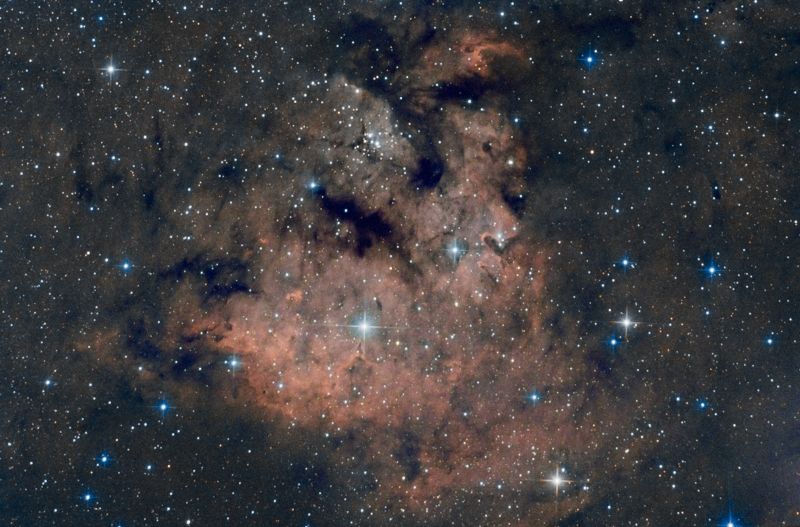
| |
| CED214 (NGC7822)
|
|
Cepheus
Vary faint and large emission nebula within NGC7822 complex |
|
| |
Pillars of gas, dust, and young, hot stars fill the center of CER214. At the edge of a giant molecular cloud toward the northern constellation Cepheus, the glowing star forming region lies about 3,000 light-years away.
Within the nebula, bright edges and tantalizing shapes are highlighted in this skyscape. The image includes data from both RGB and H-alpha filter.
The atomic emission is powered by the energetic radiation from the hot stars, whose powerful winds and radiation also sculpt and erode the denser pillar shapes. Stars could still be forming inside the pillars by gravitational collapse, but as the pillars are eroded away, any forming stars will ultimately be cutoff from their reservoir of star stuff.
The complex encompasses the emission region designated Cederblad 214 (in this image), the NGC7822 nebula and the young cluster of stars named NGC7762. The younger components aged no more than a few million years. The complex also includes one of the hottest stars discovered within 1 kpc of the Sun, namely BD+66 1673, which is an eclipsing binary system consisting of an O5V that exhibits a surface temperature of nearly 45000 K and a luminosity ~100000 times that of the Sun. The star is one of the primary sources illuminating the nebula and shaping the complex's famed pillars of creation-type formations.

Pilares de gas, polvo y estrellas jóvenes y calientes llenan el centro de CER214. Al borde de la nube molecular gigante en la constelación de Cefeo, este criadero estelar se encuentra a unos 3.000 años luz de distancia.
Dentro de la nebulosa, brillantes bordes y curiosas formas resaltan en esta vista. La imagen contiene datos de RBG y de H-alfa.
Las emisiones están alimentadas por la radiación energética de las estrellas calientes, cuyos poderosos vientos y radiación también esculpen y erosionan las densas formas de los pilares. Las estrellas podrían estar formándose dentro de los pilares por colapso gravitacional, pero mientras que los pilares se erosionan, cualquier estrella en formación será al final desgranada de su reserva de material estelar.
El complejo incluye la nebulosa Cederblad 214 (en la imagen), la nebulosa NGC7822 y un cluster de estrellas jóvenes llamado NGC7762. Los componentes más jóvenes no tienen más de unos pocos millones de años. El complejo también contiene una de las estrellas más calientes descubiertas en un radio de 1000 parsecs del Sol, llamada BD+66 1673, que es una binaria eclipsante que presenta una temperatura superficial de unos 45.000ºK y una luminosidad unas 100.000 veces la del Sol. La estrella es una de las fuentes primarias de iluminación de la nebulosa y modela la compleja formación del tipo "pilares de la creación".
|
|
| |
| Technical details: |
|
Location: |
Soria - Spain |
Date: |
17/07/2010 (dd/mm/yyyy) |
Conditions: |
Good |
Temperature: |
12-15ºC |
Humidity: |
55-79 |
|
|
Telescope: |
GSO Reflector 200mm f/4
|
Reducer/corrector: |
Baader MPCC
|
Filter: |
IDAS LPS 2"
|
Mount: |
Vixen GPD2 Autostar Meade
|
Camera: |
Canon 350D no filter
|
Exposure: |
4h (24x600s) RGB + 1h (1200s) Ha @800iso |
Guiding tube: |
B&C 60/350 f7
|
Guiding camera: |
Meade DSI Pro
|
Guiding software: |
PHD Guiding
|
|
|
Procesing: |
Calibration: 5h total light exposure, 60 flats, 20 offset, 18 darks.
Processing: PixInsight Core: RBG + Luminance (Ha) combination. Levels, curves, masked HDRWavelets and ACDNR noise reduction. |
|
Notes: |
|
|
| |
|
|
|

